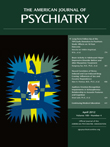Brain Activity in Adolescent Major Depressive Disorder Before and After Fluoxetine Treatment
Abstract
Objective:
Major depression in adolescents is a significant public health concern because of its frequency and severity. To examine the neurobiological basis of depression in this population, the authors studied functional activation characteristics of the brain before and after antidepressant treatment in antidepressant-naive depressed adolescents and healthy comparison subjects.
Method:
Depressed (N=19) and healthy (N=21) adolescents, ages 11 to 18 years, underwent functional MRI assessment while viewing fearful and neutral facial expressions at baseline and again 8 weeks later. The depressed adolescents received 8 weeks of open-label fluoxetine treatment after their baseline scan.
Results:
Voxel-wise whole brain analyses showed that depressed youths have exaggerated brain activation compared with healthy comparison subjects in multiple regions, including the frontal, temporal, and limbic cortices. The 8 weeks of fluoxetine treatment normalized most of these regions of hyperactivity in the depressed group. Region-of-interest analyses of the areas involved in emotion processing indicated that before treatment, depressed youths had significantly greater activations to fearful relative to neutral facial expressions than did healthy comparison subjects in the amygdala, orbitofrontal cortex, and subgenual anterior cingulate cortex bilaterally. Fluoxetine treatment decreased activations in all three regions, as compared with the repeat scans of healthy comparison subjects.
Conclusions:
While effective treatments are available, the impact of depression and its treatment on the brain in adolescents is understudied. This study confirms increases in brain activation in untreated depressed adolescents and demonstrates reductions in these aberrant activations with treatment.



